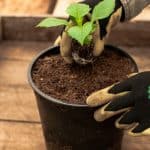Last updated on March 8th, 2022
Our site is reader supported, this means we may earn a small commission from Amazon and other affiliates when you buy through links on our site.
Dahlias are popular for the bright flowers available in a range of colours. However, they do grow particularly high and can get very heavy, which causes gardeners to prefer the prospect of growing them in pots. While tall varieties might need a support structure here and there, Dahlias can absolutely survive effectively in large containers as long as they have the right growing conditions and you give them a little bit of care.
In general, smaller varieties, for example, bedding dahlias, only grow to around 2ft so they don’t need staking and this makes them perfect for planting in pots. However, larger varieties can reach 4-5ft, these can be grown in much larger pots and staked and they will still grow well. A word of warning, Dahlias in pots need plenty of water, especially in warm weather. They prefer to be soaked down occasionally, rather than watered sparingly and daily.
Recommended Varieties
When you purchase your Dahlias it’s important that you pick low-growing varieties or dwarf varieties if you plan to grow them specifically in smaller containers. As already mentioned, growing Dahlias in pots requires particularly large pots if you choose taller specimens that reach upwards of 1.5 metres, but it is possible.
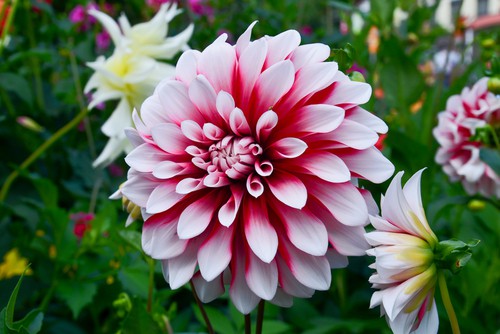
‘Bednall Beauty’ is one option that only reaches around 60cm in height. Another recommended variety is the ‘Bishop of Llandaff’, this one reaches approximately 3ft so is a little on the taller side but still grows well in pots. If you have larger pots and are willing to accommodate a bigger Dahlia you can choose the ‘Hadrian’s Sunlight’ which reaches up to 4ft or ‘Twinings After 8’ that can grow even higher.
Regardless of the variety you choose, when growing Dahlias in containers are aware of the fact that a single tuber will require between 30cm and 60cm of space, so chances are you will only plant one per container unless you have a really large tub.
Pots and Containers
It’s important to pick pots that are at a minimum of 30cm by 30 cm, any smaller and they won’t do well and keeping them moist will be nearly impossible. If you are picking a larger variety of Dahlia, you will need a pot that is at least 60cm by 66cm that can hold plenty of good rich free-draining compost.
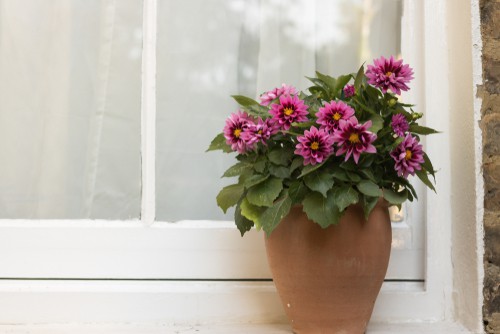
For larger Dahlias use heavy pots and stake with canes as they grow
The larger varieties will get very top-heavy, a concern for many gardeners. To combat this you are going to need to choose a pot that is strong enough to support a large amount of top-heavy weight. Additionally, you will probably need to add a stake to give the plants extra support.
The type of material you should use includes something like ceramic or terracotta because this will help prevent them from blowing over in the wind. However, if you pick terracotta pots they do tend to absorb water so you don’t want to leave the containers outside during very cold winters because they can freeze and crack, even if they are labelled as frost resistant, remember frost-resistant is not the same as frost proof.
Ensure you have adequate drainage holes
Should it be necessary, make sure you add additional drainage holes. You can drill some extra holes to help your Dahlias grow because they do require a great deal of water but they will succumb to root rot very quickly if the soil is waterlogged. Additionally, you can add approximately 5cm of gravel or broken crockery to the base of your pot before you plant it.
Planting Dahlias in Pots
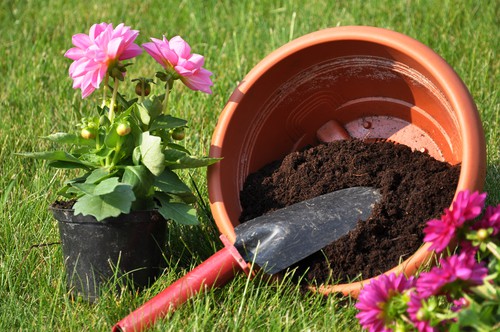
Compost for Dahlias
When you are ready to plant your Dahlias combine a mixture of two parts of good quality potting soil with one part grit to improve drainage. You may be okay just using a good quality compost but we always like to add a little grit, however, with bedding Dahlias in small pots we would probably just use compost.
Only place them outdoors after the threat of freezing temperatures has passed, in most of the UK this is the end of May but in Scotland, it can be well into June. If you plant your Dahlias outside too soon, and there is a pending frost, you can move the containers inside to protect them.
You want to fill the bottom layer of the pot or container with gravel or crockery, after which, you can add the soil until it is just shy of the rim of the container by approximately 15cm. You want to allow this soil to remain loose so don’t pack it in tightly.
Once you have the compost in place, add some fertiliser on top followed by a light layer of soil to cover the fertiliser and water it lightly so that the soil is damp but not waterlogged. If you plan on putting a stake into the container to support your larger Dahlias as they grow, decide beforehand where you’re going to place it so that it’s right next to the tuber, and make sure it is tall enough to reach the bottom of your pot and reach approximately one metre above the top of the soil.
Winter Care
When it comes time for winter you can cut back your tubers until they are approximately 15cm from the ground. Leave them for another two weeks so that they can dry out inside the pot, and after this, dig them out of the container, remove all the compost and leave them to dry for another week or two. Finally, take the tubers and store them in a dark and dry location, a place that remains approximately between 4 and 10 degrees C throughout the winter, for example, a shed or garage. Come spring you can take them out and replant them back into their pots with new compost.
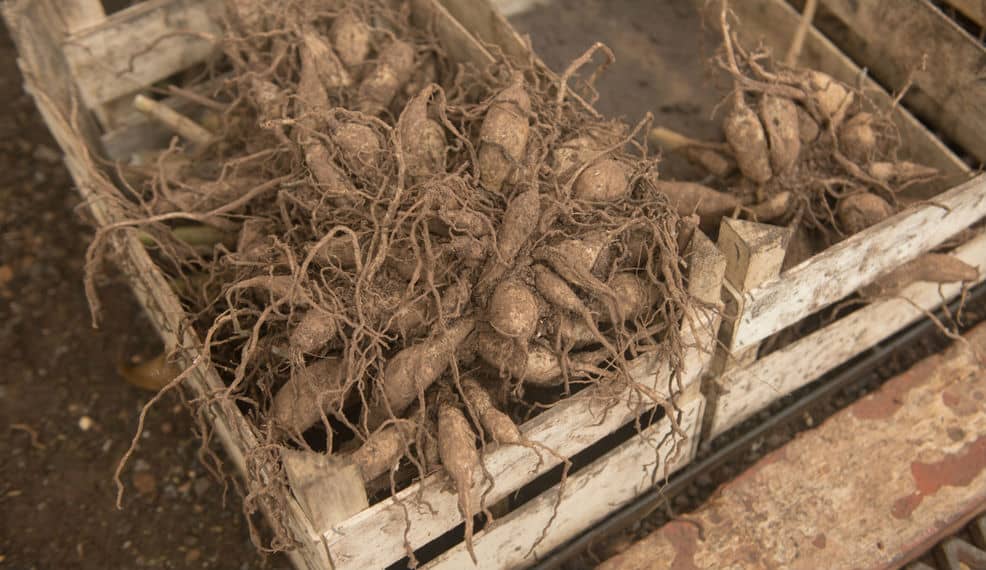
If you don’t like the idea of lifting them you can try leaving the pot undercover, somewhere dry and frost-free, such as in a shed. The following spring, all being well, you can remove the tubers and plant as normal in fresh compost.
You can learn more about overwintering Dahlia tubers here.
Feeding
When you are feeding your Dahlias it’s important to do it every two weeks while they are in bloom. Purchase a liquid fertiliser if you can that has a high amount of potassium to encourage better root development and phosphorus to help promote flower production. Tomato feed is actually perfect for this, however, any general garden feed you use while feeding your other plants weekly should be fine.
Do you want to propagate more Dahlias? Consider taking cuttings as described here or dividing tubers which we also discuss here.
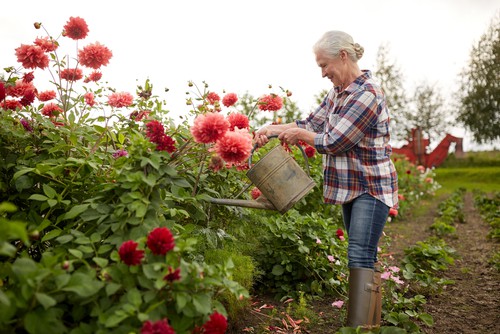
Image credits – Shutterstock.com

